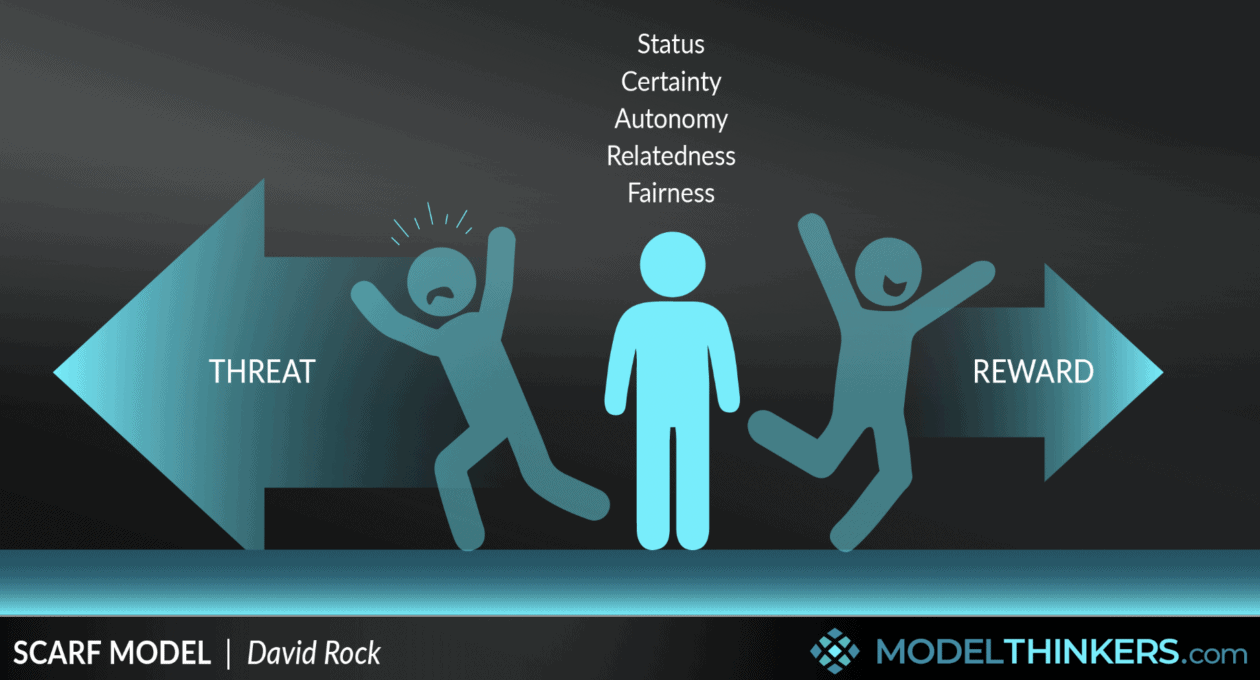In a recent implementation of Lean Portfolio Management (LPM), we encountered a significant challenge – making the change stick. While SAFe (Scaled Agile Framework) and its Lean Portfolio Management approach provide effective practices and processes, the true test lies in the realm of change management. How do we guide individuals to adopt new habits and exhibit different behaviours within this new environment?
LPM has gained popularity for its adeptness in providing strategic alignment and promoting collaboration across large enterprises. However, implementing SAFe LPM successfully requires a thoughtful approach to change management too.
In this blog post, we will explore our strategy of combining David Rock’s SCARF model with user personas to facilitate a seamless and people-centric rollout of change management during a SAFe LPM implementation.
Understanding David Rock’s SCARF Model

The initial challenge we faced was securing buy-in from the people working within the portfolio. We needed to ensure we effectively communicated the “what’s in it for me?” (WIIFM). To achieve this, we decided to create change management personas using the SCARF model to help us build a communication matrix.
The SCARF model, introduced by David Rock in 2008, is a neuroscience-based framework that explores the social aspects of human interactions. The acronym SCARF stands for Status, Certainty, Autonomy, Relatedness, and Fairness.
The Five Influential Dimensions of the SCARF Model
These five dimensions significantly influence human behaviour and can either foster a positive response or trigger a threat response when violated during times of change.
Status: The need for social standing and respect. People feel rewarded and motivated when they experience a boost in their status, whereas a perceived decrease can lead to negative reactions.
Certainty: The desire for predictability and a sense of security. Individuals seek clarity and stability in their environment, and uncertainty can cause stress and resistance to change.
Autonomy: The need for a sense of control and the ability to make choices. People want to feel empowered and be able to influence their surroundings.
Relatedness: The need for social connection and a sense of belonging. Positive relationships at work contribute to higher engagement and willingness to embrace change.
Fairness: The need for equitable treatment. People expect fairness in decision-making processes, rewards, and distribution of resources.
Utilising User Personas in SAFe Lean Portfolio Management
Understanding User Personas
User personas are fictitious characters representing various stakeholders within an organisation. They stem from real data and aid teams in empathising with end-users, grasping their needs, and customising solutions accordingly.
In the context of us implementing SAFe LPM, our user personas offered insights into how different individuals would be impacted by changes such as the introducing a Portfolio Kanban, attending portfolio syncs and experimenting with Participatory Budgeting. The user personas gave us insight into what specific concerns and preferences they may have.
Creating User Personsas
We interviewed a number of different people who were impacted by the changes that we were introducing, asking them questions such as;
- What are your goals and motivations for adopting LPM practices?
- What are your fears and frustrations when adopting LPM?
- What are some of your day-to-day tasks that enable you to perform your role within the portfolio?
- What do you need from how the portfolio operates in order to be successful?
Applying Your Learnings
Through these interviews, we identified eight personas. A common theme throughout was a fear of losing some empowerment. This relates specifically to the dimension of autonomy highlighted in the SCARF model.
There are some misconceptions that adopting SAFe removes autonomy, creativity, and agility from the teams. To dispel these notions, we turned to the SCARF model to help us craft our change management strategy.
Our messaging, training, and coaching emphasised how this new way of working amplifies empowerment and team capabilities. It offers clear alignment, visualises work flow, decentralises decision-making, and prioritises objectives.
Merging the SCARF Model with User Personas for Effective Change Management
Identify Stakeholders: Begin by identifying key stakeholders who will be impacted by the SAFe LPM implementation. These stakeholders can include executives, managers, team members, and other relevant parties.
Create User Personas: Develop user personas for each stakeholder group. Consider their roles, responsibilities, pain points, motivations, and communication preferences. Be clear that the user personas are fictitious and anonymous, you want people to be as open and honest as possible. It helps to have an independent third party to conduct these interviews.
Assess SCARF Dimensions: For each user persona, assess how the SCARF model’s dimensions apply to them. Understand what factors may enhance or threaten their sense of status, certainty, autonomy, relatedness, and fairness during the change process.
Tailor Change Communication: Create a communication matrix using the SCARF model to help you to craft change communications that resonate with each user persona. Address their specific concerns and emphasise the benefits that align with their needs and motivations.
Provide Support: Offer support and training tailored to the needs of each user persona. Empower them with the tools and knowledge necessary to navigate the changes effectively.
Encourage Collaboration: Foster a culture of collaboration and open communication to strengthen relatedness among stakeholders. Encouraging a sense of unity and shared purpose can ease resistance to change.
Acknowledge and Address Concerns: Be receptive to feedback and concerns raised by different stakeholder groups. Address any perceived inequities and involve stakeholders in decision-making processes where appropriate.
Consider the Human Element
The successful implementation of SAFe Lean Portfolio Management hinges on effective change management that considers the human element. By combining David Rock’s SCARF model with user personas, organisations can create a more people-centric approach to change.
Understanding and addressing the needs of stakeholders in terms of status, certainty, autonomy, relatedness, and fairness allows for smoother transitions and a higher likelihood of successful adoption. By putting people first and leveraging these psychological insights, organisations can embrace change as a positive force and achieve their strategic goals in the SAFe LPM journey.
Get in touch today to learn how our agile consultants can help you and your business.

![[Case Study] OKR Training, Consultancy and Implementation for Numatic International Ltd](https://www.mckennaagileconsultants.com/wp-content/uploads/2024/08/Case-Study-OKR-Training-Consultancy-and-Implementation-for-Numatic-International-Ltd-820x547.png)
